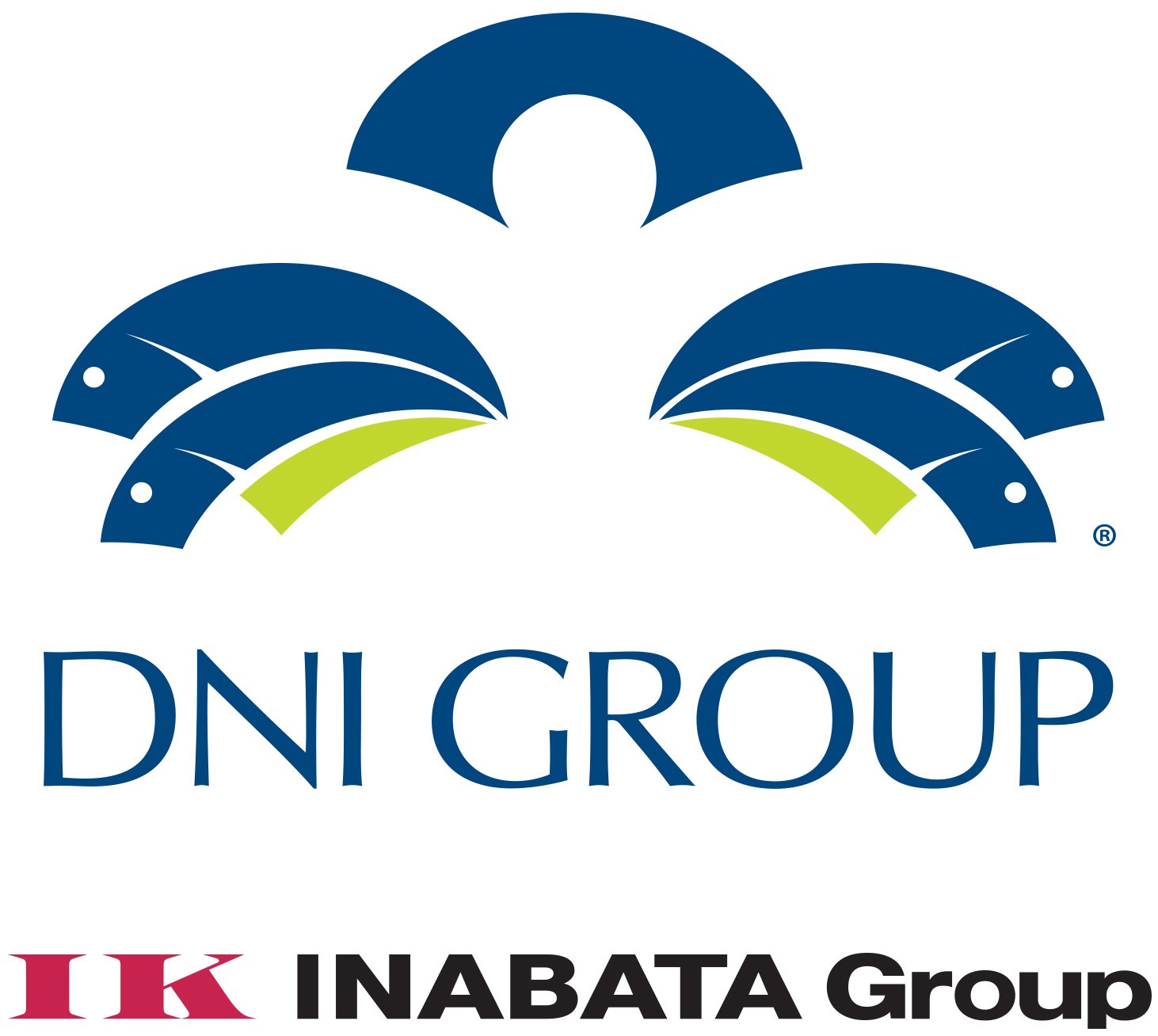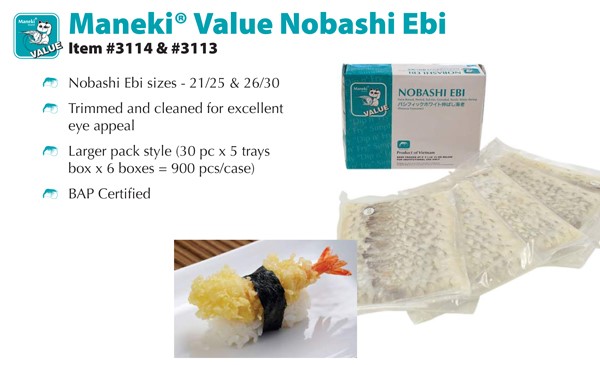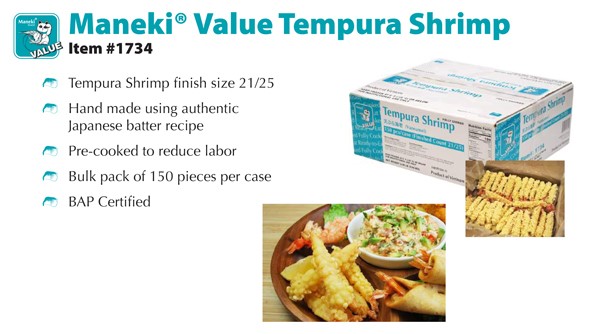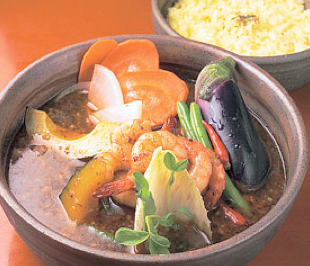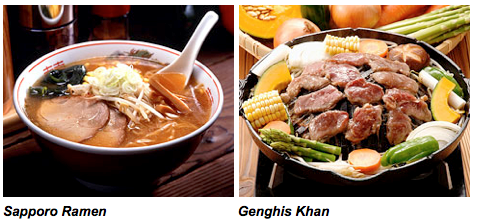Winter 2018
We welcome in the New Year and its first publication, the "DNI Group Newsletter - Winter Issue 2018". You'll find a variety of topics, among them:
- DNI Group President, Devan Nielsen shares his thoughts on what you can expect to see from DNI Group in the new year
- We take an inside look at our family of Maneki® Value products - Sushi Ebi, Nobashi Ebi, Tempura Shrimp and Panko Breaded Shrimp
- According to the Industry Update, salmon and shrimp aquaculture continue to drive seafood supply growth
- We visit Sapporo, Hokkaido's Culinary Hub with a food culture unique to Japan's Northern Island
- The Salmon Report explores the argument that 'Clean Fish' Bring Danger of Disease to Salmon Farms
- Statistics show shrimp exports from India are soaring
- See what's hot for the food trends in 2018...you'll find them here
As we step into 2018, please accept our warmest wishes for a happy, healthy and prosperous new year. We hope you enjoy this issue and as always, thank you for your continued support.
New Year Message from the President
Devan Nielsen, President
I am personally grateful to each one of our customers for their support throughout 2017. We know there are many seafood product vendors in the market and we are deeply appreciative for your continued loyalty and support. I hope we have made a positive contribution to the success of your goals in 2017. As always, it is our intention to be your trustworthy business partner focusing on a win-win outcome for the long term.
As we enter the New Year, please know that DNI Group will continue to offer high quality sashimi grade seafood and authentic Japanese appetizers. It remains clear that a constant, reliable supply chain is the foundation for a successful seafood business and this continues to be a priority at our company. It is only with a steady, stable supply chain that we are able to provide you with quality products, accurate service, reliable inventory and timely delivery.
We are looking forward to continuous improvement in 2018. Last month we moved into a brand new office and fully equipped test kitchen. In the last 6 months we have added an additional relationship manager and traffic coordinator to strengthen our client satisfaction. As for new products, our sales team will be introducing our new Crane Bay® Kani Kama and Crane Bay® Sashimi Grade Atlantic Salmon Pre-Cut Trim E.
On behalf of myself and all the staff at DNI Group, please accept our best wishes for a peaceful, happy and prosperous 2018. We look forward to experiencing continued mutual success in the New Year.
Warm Regards,
Devan Nielsen
President
PRODUCT SPOTLIGHT: Maneki® Value Family of Products
We're kicking off 2018 with a look at our growing family of Maneki® Value Products - let's begin here...
The Maneki® Value brand was officially launched in October, 2015. It was developed specifically to introduce a new line of low cost - high value shrimp products. Our goal was to combine great quality with competitive pricing to meet both your specs and price point. We began with Maneki® Value Nobashi Ebi and Sushi Ebi - both BAP certified products in limited but popular sizes and larger pack styles.
- In January, 2017, we added Maneki® Value Tempura Shrimp in size 21/25, 150 pieces per case, bulk packed and BAP certified.
- In July, 2017, we introduced Maneki® Value Panko Breaded Shrimp in size 16/20, packed in bulk with 125 pieces per case and BAP certified.
Reading on, you will find specifications and features of these four products. All the products are available in our three warehouses in Los Angeles, Newark, NJ and Miami, FL.
Product Videos
Click on any of the Product Videos below to learn more about
Maneki® Value shrimp items from our Corporate Chef, Kevin Lee:
We hope this information will be useful for you and your customers. Should you have any questions, please contact your DNI Group representative today
RECIPE IDEA: Maneki® Value Tempura Shrimp Breakfast Nachos
Crane Bay® Panko Breaded Shrimp Breakfast Nachos
Tempura Shrimp for Breakfast...why not! Hidden underneath crunchy Maneki® Value Panko Breaded Shrimp and tortilla chips lie scrambled eggs and country style spicy sausage gravy. Top with popular garnishes of jalapeno, cherry tomato, avocado, crema and scallions for a zesty, flavorful way to start the day.
INDUSTRY UPDATE: Salmon, shrimp aquaculture continues to drive seafood supply growth
Aquaculture supply is expected to continue its growth in 2018, albeit at a gradually declining rate, Rabobank has said in a new report on global protein markets. Global growth in both 2017 and 2018 is estimated to be in the range of 3-4% in volume terms, Rabobank stated in the report.
Despite good growth, persistent risks - such as disease issues, trade policies and weather problems - continue, especially in Asia, which is the most important producer of farmed seafood, the bank wrote.
An expected slowing or stagnation of production in China, the largest producer, is expected to be offset by new growth regions, especially in Southeast Asia, Latin America and Africa. India is an example of a rapidly growing export-oriented aquaculture industry, which has been doing well in 2017.
Meanwhile, wild catches are expected to experience a mild recovery as El Nino recedes, according to Rabobank. The wild catch sector is fairly stable in global harvest volumes, with increasingly well managed fisheries. Overall wild catch in 2017 should recover by 1-2% and remain at this level of production in 2018.
The recovery from El Nino, which saw improved catches in 2017, should continue, at least in the first half of 2018, Rabobank said.
Salmon Market in Recovery Mode
After a record contraction in 2016, major salmon producers Norway and Chile recovered strongly in 2017, though this growth will not persist beyond 21018, Rabobank feels. In 2017 both Chile and Norway experienced a reversal of fortunes, with growth resuming after a record contraction due to an algal bloom in Chile and sea lice resistance in 2016.
"We expect supply growth of about 5% in 2017, with slightly higher growth projected for 2018. The last quarter of 2017 and the first half of 2018 are expected to see strong supply growth, but this will not persist. Some months could reach double-digit growth. However, legislative constraints, especially in Chile, will cause supply to drop below long-term demand before the end of 2018, Rabobank's report reads
The first half of 2017 saw new record salmon prices globally, with prices in Norway breaching the NOK 70/kg mark for a second and third time, but by the end of summer, prices were back below 2016 levels, indicating that the peak of the cycle has now passed, according to Rabobank.
"We expect somewhat lower prices for 2018. Nevertheless, we are still in a long-term supply-constrained environment with good demand globally. We do not expect prices to fall to historical averages. If there is a price correction, it will probably occur in late summer 2018 and be short-lived. We expect salmon prices to be in the range of NOK 50/kg to NOK 65/kg in 2018, and to remain as volatile and unpredictable as they have been in recent years." Rabobank said.
Shrimp Industry Likely to Continue Growing
Rabobank expects the gradual shrimp supply growth of 2017 to persist, as a number of regions such as India and Ecuador continue expanding supply; provided early mortality syndrome (EMS) and Enterocytozoon hepatopenaei (EHP) pressures remain under control. The shrimp industry resumed moderate growth in 2017, with India and Ecuador being the main drivers. China and Thailand did not show the recovery expected during 2017, with EHP in these countries now emerging as an equal or even greater threat than EMS, Robabank said.
"We expect the good momentum in supply growth to continue in India and Ecuador in 2018, with some hopes that Indonesia could join these countries as a significant growth driver," Rabobank said.
Supply growth in 2017 was matched with demand growth, resulting in fairly stable prices at a level only slightly higher than the long term average. This comes at a time when a number of high-end seafood and meat products have reached - or are close to reaching - historical highs.
"We believe this to be demand-creating for the shrimp industry and at current price levels, we expect good demand for shrimp in 2018. If some of the bullish supply expectations materialize, 2018 will be a good year for the sector, with firm prices but no excessive price volatility," Rabobank said.
Taken from Undercurrentnews.com November, 2017
JAPANESE CULTURE: Sapporo, Hokkaido's Culinary Hub
A Food Culture Unique to Japan's Northern Island
Soup Curry
Hokkaido is home to a rich variety of foodstuffs, and Sapporo is a great place to find fresh seafood and any number of agricultural products. With a population of about 1.89 million, Sapporo is the largest city in northern Japan. It developed as the main urban center of Hokkaido, and its international profile grew considerably in 1972, when it became the first Asian city to host the Winter Olympics.
Soup Curry a Sapporo Favorite
Soup curry has taken root as a Sapporo favorite after taking the culinary scene by storm. Typical Japanese curry is fairly thick, as it uses a roux base that includes fried flour. Soup curry, by contrast, is thin and marked by heavy spices. A deep bowl is filled with potatoes, carrots, and other vegetables, and diners can choose to add chicken, pork, or another main ingredient, and they can also choose the spiciness of the "soup."
The owner of a popular restaurant in Sapporo's Chuo Ward explains the factors behind the boom: "Sapporo has always had a soup culture. Soup with lots of vegetables in it is an archetypal Hokkaido dish." With local fresh vegetables available at low prices, it is little wonder that soup curry has taken off there.
Traditional Local Food Alive and Well
Some 14 million tourists visit Sapporo annually, and it is believed that the vast majority eat ramen while they are there. Different types of ramen often bear the name of the place where that style of noodle originated, such as Hakata ramen and Kitakata ramen. Sapporo ramen is one of the best known and most popular of these types. The base of the soup in Sapporo ramen is miso, and the noodles are thicker than average and crinkly. Generous helpings of onion, bean sprouts, and other toppings complement the flavor of the soup.
Genghis Khan
In addition to ramen, the local cuisine known as Genghis Khan, which features lamb or mutton and vegetables broiled together on a helmet-shaped hot plate, remains popular. It has been designated as a piece of Hokkaido Heritage, a cultural asset of Hokkaido that should be preserved for future generations. As Hokkaido is so vast, the methods of preparing and eating this dish vary by locale, but visitors to Sapporo will find all the regional varieties of Genghis Khan available to sample.
With its naturally fresh foodstuffs and skilled chefs, this northern city provides visitors with a mouth-watering range of dining options.
- Taken from Trends in Japan
INDUSTRY REPORT: 'Clean Fish' Bring Danger of Disease to Salmon Farms
Thousands of fish kept in cages with farmed salmon as a natural solution to deadly sea lice blighting Scottish aquaculture risk bringing "more problems than they fix", campaigners have warned. Wrasse and lumpfish, which feed on parasitic lice, are being caught and farmed in growing numbers, but critics of salmon farming claim that such "cleaner fish" threaten to introduce other diseases and infections.
They point to a scientific report from Norway, an aquaculture pioneer, that warns of a "high" risk that cleaner fish could introduce new viruses. "Far from being a panacea, scientific research shows that cleaner fish are vectors of disease transfer and carry huge disease risks," said Don Staniford, director of campaign group Global Alliance Against Industrial Aquaculture. "It's pretty obvious that they can bring infectious diseases and spread more. Cleaner fish only deal with sea lice - but bring a hell of a lot more problems to the table."
The Norwegian Scientific Committee for Food and Environment published a report earlier this month that stated: "The disease status of wild-caught cleaner fish is, in general, poorly known. Translocations of such fish may result in the introduction of new pathogens to farmed salmonids." It added that using wild caught cleaner fish that had been moved from areas where disease was endemic to those free from disease might bring a "high" risk of infecting salmon farms with the deadly salmonid alphavirus.
While vaccinations can protect farmed salmon from some of the threats considered, the report also raised suspicion that the potentially lethal amoebic gill disease was passed from cleaner fish to farmed Atlantic salmon in Norway.
However, Scott Landsburgh, chief executive of the Scottish Salmon Producers' Organization, accused critics of using "well intentioned studies to promote speculation". "To our knowledge, no disease has been introduced to salmon as a result of using cleaner fish," he said. "We monitor each species and ensure their health is optimised. If we need to respond, we will."
Landsburgh added that cleaner fish had been "hugely" beneficial to Scotland's aquaculture and the sector was reviewing its "world-leading" code of good practice. That code already included screening cleaner fish before use and continually monitoring the health of salmon and cleaner fish "throughout production", with "action taken" if necessary.
Marine Harvest, a Norwegian firm with fish farms in Scotland, said the benefits of using cleaner fish "far outweigh any possible risks to our farmed salmon".
-Taken from SeafoodNews.com, January 2018
UPCOMING EVENTS: Seafood Expo North America
SALMON INDEX: December Report -
Data from November 2017
FOOD TRENDS: Top 14 Food Trends of 2018
Whole Foods and The Specialty Food Association-a trade association made up of food artisans, importers, and entrepreneurs-just released their annual food trend reports that predict which eats will rise to stardom and transition from niche to mainstream in 2018. The Amazon-owned retailer consulted its global insiders, from sommeliers to meat experts, while the SFA summoned its Trendspotter Panel to discover which foods we'll become obsessed with. So read on to find out what the next year's trends are forecasted to be.
SHRIMP UPDATE:
India shrimp exports to increase strongly
Indian shrimp exports are likely to surpass 550,000 metric tons in the financial year of 2018, increasing 30% compared with the year prior, reports Business Standard.
"Following 19% volume growth registered during [the financial year of 2017], the trend continued in the first half of FY18 with volumes growing 33.6% year-on-year. India currently accounts for 35% of the global frozen shrimp exports," said rating agency Icra in a report.
Icra expects shrimp exports during FY18 to grow 25-30%, led by strong order books for Indian exporters and continued demand from main importers such as the US, said Pavethra Ponniah, vice-president and sector head of Icra.
-Taken from UndercurrentNews.com, December 2017
